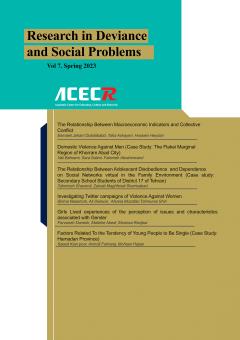-
-
-
Open Access Article
1 - Fashionism and Youth: An Emerging Social Problem
Javad Maddahi Alireza GhobadiFashion is a pervasive concept in the life cycle of the contemporary world. A phenomenon that, more than any other group, seduces young people as its followers and seems to be an emerging social problem. The purpose of this study was to investigate the socio-cultural fa MoreFashion is a pervasive concept in the life cycle of the contemporary world. A phenomenon that, more than any other group, seduces young people as its followers and seems to be an emerging social problem. The purpose of this study was to investigate the socio-cultural factors related to youth fashionism. The research method was survey and the statistical population of this research was the youth of Tehran. The sample size was 387 people which was obtained by using Cochran's formula and the sample was selected by multi-stage cluster sampling method. The data collection technique is combination of researcher-made and standard questionnaire that was evaluated for validity and reliability. The reliability measurement through Cronbach's alpha test shows an acceptable level. According to the findings of this study, there is a significant relationship between the variables of age, parental education, social class, personality, public media and social networks, religiosity and fashion. The results of regression analysis show that according to the adjusted coefficient of determination in the regression equation, 50.3% of the variance of the dependent variable is explained by independent variables. Individualism showed the strongest relationship with fashion. Also, in the section of structural equation path analysis, the model indices have an acceptable fit. Manuscript profile -
Open Access Article
2 - Pathology of the Effect of Using Social Networks on the Religiosity of Girls and Women
Tahmineh Shaverdi ReyhanehSadat Sahragard MonfardWomen in relation to the role they play in the family, influence the formation of the identity of next generation;especially due to their role as a mother whom train the children and socializing the future generation. On the other hand, changes that occurred in the worl MoreWomen in relation to the role they play in the family, influence the formation of the identity of next generation;especially due to their role as a mother whom train the children and socializing the future generation. On the other hand, changes that occurred in the world in recent decades have provided opportunities to increase this influence. The main object of current research has been understanding the relationship between the use of virtual social networks and the religiosity of women and girls. A quantitative (survey) method has been applied in this research. The research tool is a questionnaire along with an interview. The statistical population of this research consists of women and girls aged 18 to 65 from the cities of Hamedan, Shar-e-Kurd, Shiraz, Ahvaz, Tehran and Kerman, which was conducted based on the evaluation of the developmental level of the provinces announced by the Management and Planning Organization, as well as, the Internet Penetration Rate. The sample size was 1418 people and themulti-stage sampling method were applied. Findings shows that although social networks have an effect on the religiosity of women and girls of the target community,but the effect coefficients are more on ritual dimensions than on belief dimensions and experiential dimensions of religiosity. Also, finding indicat social networks have some effect on Islamic behavior. Manuscript profile
List of Articles Religiosity
-
The rights to this website are owned by the Raimag Press Management System.
Copyright © 2017-2024

